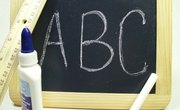Traffic signs. Directions. Texts. Emails. Reading is an essential part of daily life. When students struggle to read, teachers are more effective if the kids' exact strengths and weaknesses have been identified. Once this is done, the teacher can target instruction effectively. Diagnostic Assessments of Reading are a series of tests that assess reading skills in nine areas, including word recognition, spelling, oral and silent reading and word meaning. Teachers use DAR results to plan lessons.
Background
The DAR is a flexible tool because it can be used with ages 5 through adult. The types of tests are the same; only the difficulty level is adjusted. Although there's no time limit, the tests are usually completed in about 40 minutes. Unlike many assessments, teachers play an active role during the DAR. The teacher scores each item immediately after the student answers it. Because of this, the DAR must be given individually. Each test has simple directions, and teachers are allowed to modify and explain the instructions as needed. Although teachers may offer encouragement, they are not allowed to tell students if answers are correct.
Beginning Skills
Beginning readers, such as kindergarteners, start with a test that measures their print awareness. This assesses readers' understanding of how reading works, such as the difference between a letter and a word and the direction print moves across a page. Several tests measure phonological awareness. These indicate readers' knowledge of sounds, including rhyming words, syllables and first and final consonants in words. Another test evaluates auditory blending: the student's ability to put sounds together to make words. The final section examines a reader's skills in matching letters with the sounds they make.
Word Recognition
All readers take a DAR word recognition test because this gives the teacher an idea of the reader's basic skills. The instructor uses this information to determine the difficulty level of the rest of the tests. As the student reads a list of words, the instructor records whether each word was read correctly, incorrectly or skipped. Readers at lower levels also take sub-tests where they must identify specific consonant and vowel sounds.
Reading Passages
During an oral reading passage, the student reads a story to the teacher, who records any variations the reader made, including word substitutions, omissions and mispronunciations. The student reads a different passage silently and answers multiple-choice questions. In addition, the reader summarizes the main ideas of the piece while the teacher records the words exactly.
Oral Sections
The spelling section assesses several words. For each, the teacher reads the student a sentence, asks for one word to be spelled aloud and records the student's answer. To test knowledge of the meaning of words, the student defines several words while the teacher writes down each explanation verbatim.
Related Articles
References
Resources
Writer Bio
Living in upstate New York, Susan Sherwood is a researcher who has been writing within educational settings for more than 10 years. She has co-authored papers for Horizons Research, Inc. and the Capital Region Science Education Partnership. Sherwood has a Ph.D. in curriculum and instruction from the University at Albany.











